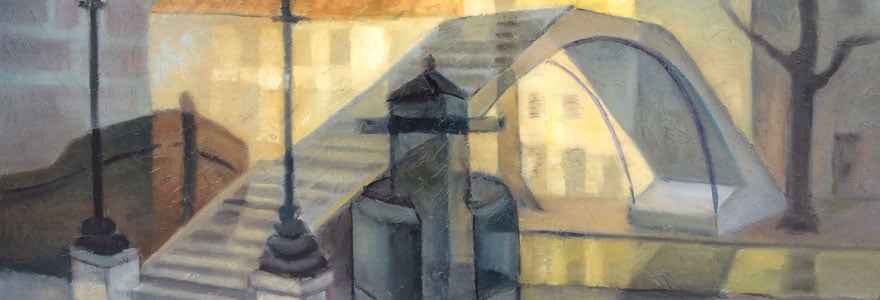Louis Toffoli was a French painter whose vibrant and dynamic art left a lasting impression on the world of modern art. His use of bold colors and expressive brushstrokes captured the essence of post-war Paris, earning him recognition as one of the city's most talented artists. Early in life, Toffoli showed a fascination for art, drawing and painting whenever he had the opportunity. This passion eventually led him to pursue formal training at the École des Arts Décoratifs in Nice, where he honed his craft and developed his unique style. Toffoli's artwork is characterized by his use of vivid colors and strong, confident lines that give his figures an energetic and dynamic quality. His work often features everyday scenes and slices of life, such as bustling cafes or bustling marketplaces, which he imbues with a sense of excitement and vitality. Some of Toffoli's most well-known works include his depictions of Parisian boulevards and bridges, which capture the city's lively atmosphere and the movement of its inhabitants. His portraits of musicians and dancers are similarly striking, offering a glimpse into the world of performance and entertainment in France. Throughout his career, Toffoli's work was exhibited in galleries and museums across Europe, like in estades.com, earning him critical acclaim and a dedicated following of fans. Today, his legacy continues to inspire new generations of artists, who look to his unique vision and daring style for inspiration and guidance.
Early Life and Artistic Training
Toffoli was born in Trieste, Italy, in 1907. His family moved to France when Toffoli was still a young boy, and he spent most of his formative years in the country. From a young age, Toffoli showed a strong interest in art and began taking painting classes when he was just 14 years old. He attended the École Nationale Supérieure des Arts Décoratifs, a prestigious art school in Paris, where he honed his skills and developed his distinctive style.
Despite his early success as an artist, Toffoli was forced to put his passion on hold during World War II. He served in the French army and was taken as a prisoner of war by the Germans. During his captivity, he managed to continue drawing and sketching, even in the most difficult circumstances, often using bits of scrap paper and charcoal that he had found. After the war, he returned to France and began painting again, producing some of his most celebrated works during this time.
Style and Themes
Toffoli's paintings are characterized by their vivid colors and bold brushstrokes. He often worked with a palette knife, creating thick layers of paint that gave his paintings a textured, almost sculptural quality. His works are primarily figurative, depicting scenes from everyday life in France. He had a particular fondness for cafés, markets, and the world of the arts, often incorporating these themes into his paintings. He was especially interested in the people he encountered in these settings, and his paintings are packed with figures, each with a unique personality and presence.
- Toffoli's use of vibrant colors and bold brushstrokes give his paintings a unique texture and depth that draws the viewer in
- His works are primarily figurative, depicting scenes from everyday life in France
- He was particularly interested in the people he encountered in cafes, markets, and other social settings, and his paintings are filled with characters, each with their own story to tell
- Toffoli's works capture the essence of life in France in the early to mid-20th century, with a particular emphasis on the country's rich cultural heritage
Popular Works
Toffoli produced a vast body of work during his lifetime, including paintings, drawings, and lithographs. Some of his most famous paintings include "Le Petit Café," "Le Marché aux Fleurs," and "L'Opéra de Paris." "Le Petit Café" depicts a bustling café scene in Paris, with a group of men gathered around a small table, chatting and playing cards. "Le Marché aux Fleurs" is a vibrant composition that captures the colors and energy of a bustling flower market. "L'Opéra de Paris" portrays the elegance and grandeur of the famous Parisian opera house, with a crowd of well-dressed attendees gathered on the steps outside.
Toffoli's works have been shown in galleries and museums around the world, and many art collectors and enthusiasts consider his paintings to be highly collectible.
Exhibitions and Recognition
Throughout his career, Toffoli participated in numerous exhibitions and shows, both in France and internationally. He was awarded the Médaille d'Or de la Ville de Paris in 1960 and was made a Chevalier de la Légion d'Honneur in 1981. His works are held in many public and private collections and are frequently displayed in galleries and museums around the world.
Legacy and Influence
Toffoli's use of color and texture has had a profound influence on the art world, and his paintings continue to inspire new generations of artists. His unique style and approach to painting, which blends impressionistic and expressionistic techniques, have earned him a place among the most important artists of the 20th century.
- Toffoli's use of color and texture has had a lasting impact on the art world, inspiring new generations of artists to experiment with different techniques and styles
- His work continues to be exhibited and celebrated around the world, cementing his legacy as one of the most respected and influential artists of his time
- Toffoli's love of life and the people he encountered on his travels shine through in each of his paintings, making them a celebration of the human experience and a testament to the enduring power of art
